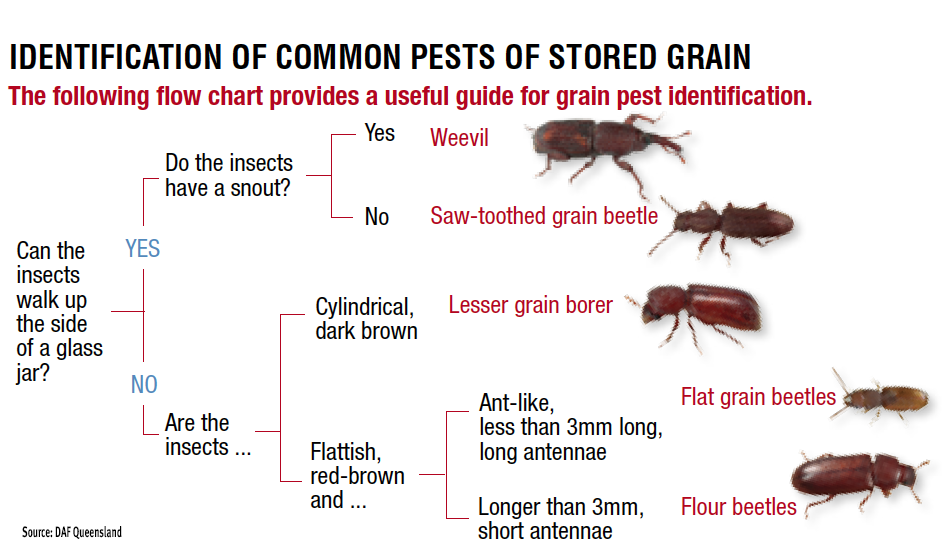Winter—time to visit your storages
As temperatures drop and hopefully winter crop planting is completed, a little time invested around your storage facility will pay dividends.
During our coldest months storage pests are not breeding rapidly and are less likely to fly. They are quietly sitting in grain residues in empty silos, or keeping warm in silos still holding grain. Winter is the best time to do a thorough clean out of empty storage and grain handling equipment. Follow up with a DE dust treatment (e.g. Dryacide®).
Check your aeration system is operating correctly, and reducing grain temperatures below 15°C to make life miserable for storage pests. None of the major storage pests can breed and increase in number below 15°C.
Winter is also a good time to carry out maintenance on your storage facility. Make it a priority to pressure test your sealable silos to detect damaged seals or other leakage points. A gas-tight silo is essential for successful fumigation when required.
Cleaning up now and reducing the pest numbers around your storage facilities will significantly reduce the early infestation of next season’s grain in storage.
Identifying insect pests in stored grain
In a deregulated grain market, the popularity of on-farm storage continues to increase and markets are now more likely to request nil chemical residues. This reduces the tools available to control pests, so good storage hygiene, well-managed aeration and regular monitoring (at least monthly) are essential. These strategies are important for stored cereal grains, oilseeds and pulses.
Early detection of storage pests with regular monthly checking allows for a timely, well-managed fumigation in a sealable, gas-tight storage. This reduces the likelihood of attempting last minute, rushed presale fumigations, which has caused problems for the industry.
Take grain samples from the bottom of silos to sieve for insects. Grain sample spears are a useful tool for shed and pad storages. A simple insect probe trap placed in the top of the grain is also helpful for early pest detection. Using both traps and a standard insect sieve (2 mm mesh) are the most effective methods of detecting grain pests.
Insect sieves should have a white tray that makes it easier to see small insects. After sieving, hold the tray in the sunlight to encourage insect movement, making pests easier to see. Correct insect identification will allow for more targeted pest control options as pest species present may be resistant to certain control products.
Keeping a monthly storage record of pests found, grain treatments applied and grain quality details for each silo, puts you in the best position when negotiating with grain buyers.
Key pest species
Cereal grains include wheat, barley, oats, triticale, sorghum and maize. Their most common pests are:
- Rice weevil (Sitophilus oryzae) and maize weevil (Sitophilus zeamais)
- Lesser grain borer: (Rhyzopertha dominica)
- Rust-red flour beetle: (Tribolium castaneum)
- Saw-toothed grain beetle: (Oryzaephilus surinamensis)
- Flat grain beetles and rusty grain beetle (Cryptolestes spp.)
- Indian meal moth: (Plodia interpunctella)
- Angoumois grain moth: (Sitotroga cerealella)
Another dozen or so beetles, psocids (booklice) and mites are sometimes present as pests in stored cereal grain.
Some of the pests found in stored pulses and oilseeds (e.g. chickpea, mungbean, canola, cottonseed, sunflower) include:
- Flour beetles
- Bruchids
- Saw-toothed grain beetles
- Moths
- Psocids
Adult beetle identification
Place live insects into a clean warm glass jar (above 20°C so they are active, but not too hot or they will die). Weevils and saw-toothed grain beetles can walk up the walls of the glass easily, but flour beetles and lesser grain borer cannot. Look closely at the insects walking up the glass — weevils have a curved snout at the front.
EXOTIC PESTS – BE ON THE LOOKOUT. Report any unusual sightings immediately to the local State department of agriculture or ring the Exotic Plant Pest Hotline on 1800 084 881.
Resistance
Poor fumigation practices, such as fumigating in unsealed silos, has increased the number of phosphine-resistant stored grain pests. Such resistance can threaten grain exports, as live insects remain in grain after fumigation. If insects survive fumigation, contact your regional grain storage specialist.
Grain storage specialists
QLD and northern NSW
- Philip Burrill m. 0427 696 500 Email: [email protected]
- Manoj Nayak (07) 3708 8539 Email: [email protected]
- Greg Daglish (07) 3708 8538 Email: [email protected]
Southern NSW, VIC, SA and TAS
- Peter Botta 0417 501 890 Email [email protected]
Grain biosecurity contacts
Plant Health Australia 02 6215 7700
Email [email protected]
www.planthealthaustralia.com.au
Further information
For more information on grain storage and pest identification, visit the Stored Grain information hub
See also:
- Stored grain pests identification (The back pocket guide)
- Stored grain pest control guide (Fact sheet)

